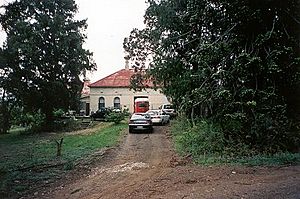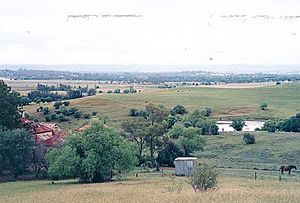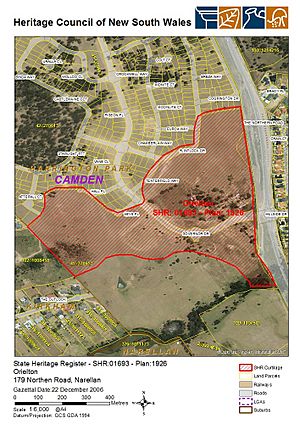Orielton, Harrington Park facts for kids
Quick facts for kids Orielton |
|
|---|---|

View of the c.1840s single storey Georgian Homestead and remnant early plantings
|
|
| Location | 181 - 183 Northern Road, Harrington Park, Camden Council, New South Wales, Australia |
| Built | 1815–1834 |
| Architectural style(s) | Victorian Italianate |
| Official name: Orielton; Orielton Farm; Orielton Homestead | |
| Type | State heritage (landscape) |
| Designated | 22 December 2006 |
| Reference no. | 1693 |
| Type | Historic Landscape |
| Category | Landscape - Cultural |
| Lua error in Module:Location_map at line 420: attempt to index field 'wikibase' (a nil value). | |
Orielton is a historic property located in Harrington Park, a suburb in south-western Sydney, New South Wales, Australia. It was once a large estate used for hunting, pleasure gardens, and farming. Over the years, it was also a weekender home, a place for growing cereals, and even had a flour mill. Today, it is used for horse agistment (where horses are kept and cared for) and as a residence.
Orielton was built between 1815 and 1834. It is also known as Orielton Farm and Orielton Homestead. The property is privately owned. It was added to the New South Wales State Heritage Register on 22 December 2006, meaning it's officially recognized as an important historical site.
Orielton's History
Early Days of Orielton
In about 1815, Edward Lord was given a large piece of land, about 655.5 hectares (1,620 acres), in the Narellan area. He named it Orielton Park. Lord had another property in Tasmania, so Orielton was likely an outstation or a place he visited. The land was probably open forest with grass, and people started clearing timber and land for farming. The flat areas along Narellan Creek were soon used to grow cereals like wheat and hay.
From 1822 to 1841, Orielton was used as an outstation by John Dickson. His brother, James Dickson, managed Orielton and a nearby property. They used Orielton for growing cereals and raising cattle and sheep. John Dickson also made cheese and had mills for grinding grain. The estate had a brick cottage, stables, and a large barn with machinery for processing crops. By 1834, many workers lived and worked on the farm. A three-storey steam mill was also built around this time.
In 1847, a miller named John Perry bought Orielton. He continued to grow cereals and use the mill to make flour. The estate was mainly used for grazing animals, with some farming.
Orielton in the Mid-1800s
In 1861, William Peisley, a butcher, bought Orielton. He later sold it in 1864 to John Thomas Neile, who lived in Sydney. Neile bought the estate in two parts, including the main farm and another farm across The Northern Road. He also bought the mill, which was considered a very good deal. The property at this time had many cleared and fenced paddocks, an orchard, and various buildings. There were also many trees, including cypress and pine trees.
In 1863, Abraham Davy, who owned the nearby Harrington Park, bought a part of Orielton Farm. By the 1870s, Orielton and Harrington Park became popular places for sports like coursing, where greyhounds chased live hares.
In 1874, William Rudd Snr, a grazier (someone who raises livestock), bought Harrington Park and parts of Orielton. He focused on raising animals. The Rudd family and their descendants owned both properties until 1933, when they were sold due to the Great Depression.
Orielton from 1876 to 1943
In 1876, Mrs. Harriet Beard bought and lived at Orielton. She made many changes to the homestead and gardens, especially to enjoy the views to the south. She added a second storey to the house in the Victorian Italianate style. Harriet also planted many trees, such as Bunya pines, hoop pines, and Moreton Bay figs. These plantings might have had special meaning, perhaps related to her husband's death.
The estate was sold in 1912 to a group of people and then leased to Ephraim Cross, a local storekeeper. The property was very large, with cleared land, paddocks, and dams. It had stables, barns, a milking shed, and two cottages. Cross later sold parts of the property. In 1928, a farm building to the north was destroyed in a fire.
In the 1930s, the Pilling family owned Orielton. They lived in Sydney and had managers run the estate. Their daughter, Eileen Pilling, remembered visiting during school holidays. She described the beautiful iron verandah, French doors, and lovely views. She also recalled a long tree-lined driveway, a carriage loop, a large aviary with colorful birds, and a tennis court. There was an orchard with nuts and fruits, and a ballroom under the house.
By 1938, the Swans family owned all remaining parts of Orielton and managed it with Harrington Park. During World War II, the army used Orielton for training and housing soldiers from 1942-1943.
Orielton After World War II
Since 1944, the Fairfax family has owned Orielton, along with the neighboring Harrington Park. The Fairfax family lived at Harrington Park, and Orielton was managed as part of that estate. Sir Warwick Oswald Fairfax used Orielton for breeding Hereford cattle. He built fences, paddocks, and shelters for his stud livestock. The old steam mill was taken down during this time.
In the 1970s, The Northern Road was changed, which affected Orielton's main driveway. A new section was added, making the driveway a "V" shape. In the 1990s, the land around Harrington Park was developed for housing, which changed the look of the Orielton estate. Some of the cattle grazing fields and shelters near Narellan Creek were removed.
Orielton's Description
Orielton's Location and Surroundings
Orielton Park is located in the Scenic Hills of the Camden Valley. It is surrounded by ridges to the north and west. Narellan Creek flows through the property, draining into the Nepean River. The soil is mostly clay.
Today, the Orielton homestead area is surrounded by open paddocks on three sides and The Northern Road on the east. New houses are being built nearby. The area gets about 750 mm of rain each year. Narellan Creek still has many trees and plants. The flat areas along the creek show signs of past farming and grazing.
The homestead area was once separated from the rest of the farm by fences. Orielton has always been connected to its rural landscape. Old photos show that the homestead worked as a complete set of buildings and spaces. The estate was generally divided into these areas:
- The main house, its gardens, and recreation areas like a tennis court.
- Gardens for picking fruits and vegetables, and orchards.
- Farm buildings and working areas, like the former mill and silos.
- Grazing pastures for animals.
- Narellan Creek and land for growing crops.
The way people entered the property changed over time. The Victorian Italianate style of the house meant that the entry became more formal, leading visitors through beautiful gardens to the house.
Gardens and Grounds
The gardens at Orielton show the design styles from the Victorian period, especially from Harriet Beard's time. To the east of the house, there is a carriage loop with many trees, including Bunya pines and a Moreton Bay fig. The area where the tennis court used to be is now used for horse agistment.
Not much of the original formal gardens remains today, except for some terracing, steps, a few trees, and rose bushes. The main formal garden was moved to the south of the house to face Narellan, Campbelltown, and Camden. The current driveway is lined with tall pines. Old photos show semi-circular garden beds in front of the Italianate part of the house.
Older trees are found on the north-east side of the house. A large Bunya pine is on the northern edge of the garden. Other large hoop and Bunya pines are also important features of the garden and driveway. Some of the significant tree species include Bunya Bunya pine, hoop pines, funeral cypress, and Moreton Bay fig.
To the west of the homestead was the working area, which included a picking garden, an orchard, and a small dam. While many structures here are gone, rows of European olive trees and old aerial photos show where these areas used to be. The orchard was still used in the 1930s for fruits and nuts. This area is now used for grazing. A large dam built in 1958 was recently removed for new housing development.
Homestead Group and Entry Drive
The main homestead faces east and south, looking out over the open rural land. The current entry drive follows the Old Northern Road, curving sharply towards the house. This drive is lined with old pines. Near the homestead, you can see signs of old hedges and gardens. A dam is located west of the main house, and an old well is near the top of the northern ridge.
The homestead itself is an old building with many additions. To the east of the main house are the stables and horse agistment area. The house was changed in the late 1800s to face towards Camden. The original entrance driveway used to come directly from The Northern Road.
Outbuildings
Orielton has several outbuildings, which are smaller buildings separate from the main house. These include:
- Silos (around 1950)
- A former Miller's Cottage or Office (around 1850, updated around 1950)
- Large Stables (around 1930, updated around 1950)
- A Hay Shed (around 1930, updated around 1950)
- An Early milking shed (around 1880)
- Stalls shed (between 1950 and 1990)
- A Concrete bin (around 1950, updated around 1990)
- Stock Yards (around 1950)
- The Mill Building (a 3-storey building from around 1830, no longer standing after 1950).
Orielton's Condition
As of 2004, Orielton still looks much like it did in the past, with the main house and its gardens next to open pastureland. The property has a lot of potential for archaeological discoveries, as it has been continuously developed since about 1815. Orielton still has its connection to natural features like Narellan Creek and the surrounding hills, and its open rural landscapes.
Changes Over Time
- Late 1800s: Additions were made to the house, and its entrance was changed to face towards Camden.
- World War II: The army occupied the site, causing significant changes to the house.
- Around 1940s: The orchards west of the homestead were no longer used.
- Around 1958: A large dam was built by Warwick Fairfax.
- Around 1990: Farming paddocks south-west of the homestead were turned into grazing land.
- Before 2005: The new suburb of Harrington Park was built, including part of Orielton's estate. The Northern Road was changed, affecting Orielton's driveway.
- Before 2013: New large houses were built near Orielton's south-west side.
- Around 2013-2014: The area where the tennis court used to be was expanded with material from road works.
- 2014: The large dam built in 1958 was removed for new housing development.
Orielton's Heritage Listing
Orielton is considered very important to the history of New South Wales for several reasons:
- It is a great example of a large estate from the 1840s, and possibly even earlier from the 1820s.
- It had a mill for grinding wheat, which was an important early industry. The way the house and other buildings have been used for different purposes over time is a key part of its history.
- The way Orielton was built and how its buildings and gardens are arranged shows how a large farm for wealthy people changed from early colonial times until today.
- The buildings and layout of Orielton show how estates were developed and how farming was done, especially for wheat and flour. There might be old remains underground that could teach us more about its past.
- Orielton is beautiful because it has parts of Georgian design and also Italianate design, which is rare for rural properties. Its location in the countryside and its views are also very important.
- The gardens around the house are special because they still have some of the original plants and garden designs. The large Bunya and Norfolk Island pines make the house stand out in the landscape.
- Orielton has strong connections to important landowners and respected families, like the Fairfax family today. It was also used by the army during World War II.
Orielton is especially significant because its rural setting is still mostly untouched, and you can clearly see how the house and farm buildings worked together. Its different land features, like ridges and slopes, add to its beauty and purpose. It also has important visual links to nearby properties like Harrington Park and Studley Park, and to St John's Church in Cobbitty.
Orielton was added to the New South Wales State Heritage Register on 22 December 2006.



